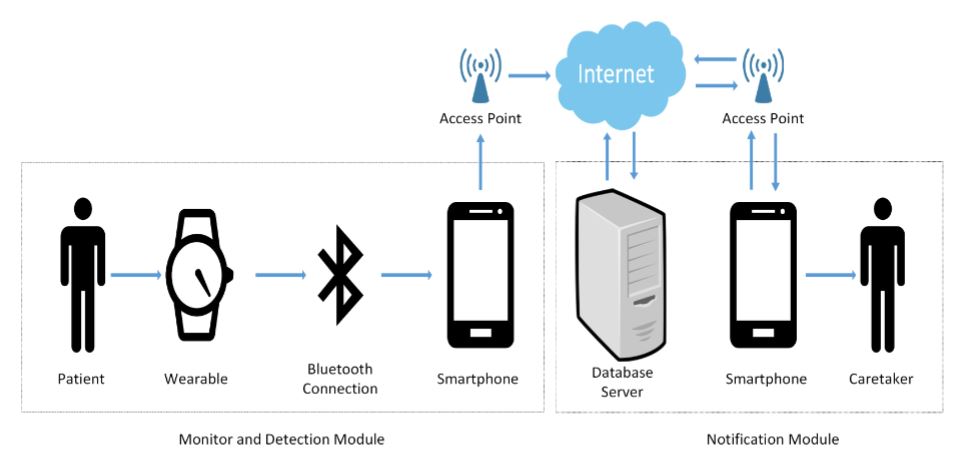A System for Sleepwalking Accident Prevention Utilizing the Remote Sensor of Wearable Device
Main Article Content
Abstract
Sleepwalking is a type of sleep disorder which originates during deep sleep and results in walking state and performing series of complex behaviors or actions while sleeping. In some cases, sleepwalking patients can injure themselves from their actions such as driving a car or climbing out of a window. In addition, to wake up the sleepwalkers can be difficult. The suddenly waking up and can cause them to be confused or even attack the person who wakes them. Therefore, detecting the sleepwalking incident in an early state can help the caretaker or family members to stop the patients before they harm themselves from any strange, inappropriate, or violent behaviors. In this research, we present a prototype system of sleepwalking detection algorithm and notification system using smart device which work coordinating with wearable device. There are two main groups of users; patients and caretakers. User Activity Sensor (UAS) in the wearable device is utilized for detecting User Activity Data (UAD) which is unusual activities of inducing a sleepwalking patient provided by the Remote Sensor SDK. The system returns the patient UAD states consisting of standing, walking, and running. The smart device accepts the UAD states from the wearable device, performs sleepwalking detection algorithms then, alarms caretakers when the sleepwalking state has already invoked. The system is implemented, built, tested and deployed. The threefold experimental measurement of physical user activites have been performed to validate our proposed sleepwalking detection algorithms. The system correctly detects the sleepwalking states and notifies the caretaker.
Article Details

This work is licensed under a Creative Commons Attribution-NonCommercial-NoDerivatives 4.0 International License.
References
A. Galbiati, F. Rinaldi, E. Giora, L. Ferini- Strambi, and S. Marelli, “Behavioural and Cognitive-Behavioural Treatments of Parasom- nias,” Behavioural neurology, vol. 2015, no. 5, pp. 1–8, 2015.
O. Cabka, “Somnambulism, or sleep-walking, still remains most mysterious disease,” https://www.pravdareport.com/science/tech/ 30-12-2005/9462-somnambulism-0/, 2005, [Online; accessed 14-December-2019].
American Acedemy of SLEEP MEDICINE (AASM), “Sleepwalking - Overview&Facts,” https://sleepeducation.org/ sleep-disorders-by-category/parasomnias/ sleepwalking/overview-facts, 2018, [Online; accessed 14-December-2019].
P. K. Atrey, M. A. Hossain, and A. E. Saddik, “A Multimedia-Based System for Monitoring Sleep- walkers,” in 2007 IEEE International Confer- ence on Signal Processing and Communications, Nov 2007, pp. 1459–1462.
M. J. Sateia, “International classification of sleep disorders-: highlights and modifications,” Chest Journal, vol. 146, no. 5, pp. 1387–1394, 2014.
S. Popat and W. Winslade, “While You Were Sleepwalking: Science and Neurobiology of Sleep Disorders & the Enigma of Legal Responsibility of Violence During Parasomnia,” Neuroethics, vol. 8, no. 2, pp. 203–214, 2015.
D. Petit, M.-H. Pennestri, J. Paquet, A. De- sautels, A. Zadra, F. Vitaro, R. E. Tremblay,M. Boivin, and J. Montplaisir, “Childhood sleep- walking and sleep terrors: a longitudinal study of prevalence and familial aggregation,” JAMA pediatrics, vol. 169, no. 7, pp. 653–658, 2015.
S. S. Bhattacharya, “Intelligent monitoring sys- tems: smart room for patient’s suffering from somnambulism,” in 2nd Annual International IEEE-EMBS Special Topic Conference on Mi- crotechnologies in Medicine and Biology. Pro- ceedings (Cat. No.02EX578), May 2002, pp. 326–331.
S. Singhal and P. Jain, “Wireless health mo- nitoring system for sleepwalking patients,” in 2015 39th National Systems Conference (NSC), 12 2015, pp. 1–6.
B. H. Dobkin, “Wearable motion sensors to continuously measure real-world physical activ- ities,” Current opinion in neurology, vol. 26, no. 6, p. 602, 2013.
fitbit, “Fitbit Official Site for Activity Trackers and More,” https://www.fitbit.com/home, Au- gust 2019.
C. Zhu, W. Sheng, and M. Liu, “Wearable sensor-based behavioral anomaly detection in smart assisted living systems,” IEEE Transac- tions on Automation Science and Engineering, vol. 12, no. 4, pp. 1225–1234, 2015.
T. Wongsirichot, J. Pattanaphanchai, N. So- payada, and S. Hayeewaehama, “A prototype of sleepwalking detection and monitoring system using smart devices,” Advanced Science Letters, vol. 23, pp. 5126–5129(4), Jun. 2017.
Samsung, “Samsung Developers,” https:// developer.samsung.com/home.do, 2019, [Online; accessed 26-August-2019].
R. Hipp et al., “SQLite,” https://www.sqlite. org/index.html, December 2019, [Online; ac- cessed 14- December-2019].
Google Developers, “Firebase,” https://firebase. google.com/, December 2019, [Online; accessed 14-December-2019].
Facebook Inc., “React Native,”https://facebook.github.io/react- native/docs/getting-started, December 2019.
The Apache Software Foundation, “Apache Cor- dova,” https://cordova.apache.org/, December 2019.


